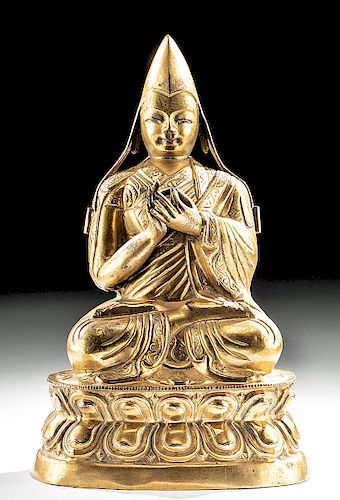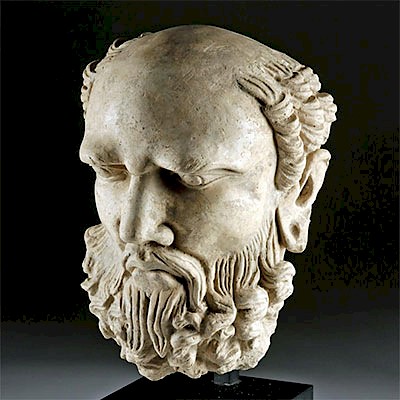Sealed 19th C. Tibetan Gilt Copper Tsongkhapa
Lot 195a
About Seller
Artemis Fine Arts
686 S Taylor Ave, Ste 106
Louisville, CO 80027
United States
Selling antiquities, ancient and ethnographic art online since 1993, Artemis Gallery specializes in Classical Antiquities (Egyptian, Greek, Roman, Near Eastern), Asian, Pre-Columbian, African / Tribal / Oceanographic art. Our extensive inventory includes pottery, stone, metal, wood, glass and textil...Read more
Categories
Estimate:
$1,800 - $2,500
Absentee vs Live bid
Two ways to bid:
- Leave a max absentee bid and the platform will bid on your behalf up to your maximum bid during the live auction.
- Bid live during the auction and your bids will be submitted real-time to the auctioneer.
Bid Increments
| Price | Bid Increment |
|---|---|
| $0 | $25 |
| $300 | $50 |
| $1,000 | $100 |
| $2,000 | $250 |
| $5,000 | $500 |
| $10,000 | $1,000 |
| $20,000 | $2,500 |
| $50,000 | $5,000 |
| $100,000 | $10,000 |
| $200,000 | $20,000 |
About Auction
By Artemis Fine Arts
Jan 16, 2020
Set Reminder
2020-01-16 10:00:00
2020-01-16 10:00:00
America/New_York
Bidsquare
Bidsquare : Ancient | Asian | Ethnographic
https://www.bidsquare.com/auctions/artemis-gallery/ancient-asian-ethnographic-4799
Featuring classical antiquities, ancient and ethnographic art from cultures encompassing the globe. Artemis Fine Arts info@artemisfinearts.com
Featuring classical antiquities, ancient and ethnographic art from cultures encompassing the globe. Artemis Fine Arts info@artemisfinearts.com
- Lot Description
Asia, Tibet, ca. 17th to 18th century CE. A magnificent gilt copper (~45% gold and 55% copper) statue of Lama Tsongkhapa (1357-1419), a 15th century scholar and philosopher of Tibet who was the founder of the Gelug Order and later named the first Dalai Lama, depicted in his iconic form, wearing a tall yellow hat and sitting in double lotus position atop a lotus pedestal. In addition to presenting an impressive form, this hollow cast sculpture is sealed with copper on the bottom of the lotus pedestal. The contents of such statues traditionally include holy articles of some type. Beyond this, Tsongkhapa holds his hands in the Dharmacakra Mudra of Long Life Posture (symbolizing turning the wheel of Dharma or the teaching of Dharma) and is elaborately dressed in silks and bejeweled ornaments. Size: 7.125" H (18.1 cm); Quality of gilding: ~45% gold.
Tsongkhapa's abhorrence of the laxity of many monastic orders gave rise to a strong foundation for the Order of the Virtuous, the Gelugpa. Since the Gelugpas wore yellow hats, this order is sometimes referred to as the Yellow Hats, distinguishing it from other orders called Red Hats. Tsongkhapa is known for restoring monastic discipline, the prohibition of the use of alcohol, and requiring strict celibacy as well as a regimented daily schedule. His honorary title is Je Rinpoche -Je meaning "exalted".
According to Meulenbeld's "Buddhist Symbolism in Tibetan Thangkas (2004): "Tsongkhapa was born of poor parents in Amdo, Eastern Tibet, in the Onion Valley. His keen intelligence was evident when he was little. At a young age, he received various degrees from his studies in Central Tibet where he mastered five main subjects taught by a Tibetan monastery university: abhidharma (metaphysics), madhyamika (the Middle Way, between Being and Non-Being), prajnaparamita (knowledge), pramana (logic), and vinaya (monastic rules) . . . Tsongkhapa founded large monasteries and universities, such as Ganden, Drepung, and Sera."
Due to the vow of celibacy, hereditary succession was not possible. The solution was to designate a new monastery abbot or lama as an incarnation of his predecessor. From this arose the succession to Yellow Hats leadership, including the Dalai Lama who is regarded as an incarnation of Avalokiteshvara. This line of Dalai Lamas began in the 16th century. Following his death, Tsongkhapa was retroactively named the first Dalai Lama.
Given the presence of the copper seal, this statue was likely created for religious practices. When such figures are consecrated, the image is first purified in order to be deemed suitable for the inhabitance of Buddha or another revered entity, in the is case Tsongkhapa. Then the statue is invested with the presence and power of that deity. Unless it has been consecrated, a statue is not considered suitable for use in religious practices. Holy articles are sealed inside.
Provenance: private Hawaii, USA collection; ex Swanhild Castle, New York, USA
All items legal to buy/sell under U.S. Statute covering cultural patrimony Code 2600, CHAPTER 14, and are guaranteed to be as described or your money back.
A Certificate of Authenticity will accompany all winning bids.
We ship worldwide and handle all shipping in-house for your convenience.
#150944Wear to red fabric over the copper seal on bottom of pedestal. A few minor scuffs to gilding and indentations to the figure, but otherwise excellent.Condition
- Shipping Info
-
All shipping is handled in-house for your convenience. Your invoice from Artemis Gallery will include shipping calculation instructions. If in doubt, please inquire BEFORE bidding for estimated shipping costs for individual items.
-
- Buyer's Premium



 EUR
EUR CAD
CAD AUD
AUD GBP
GBP MXN
MXN HKD
HKD CNY
CNY MYR
MYR SEK
SEK SGD
SGD CHF
CHF THB
THB















